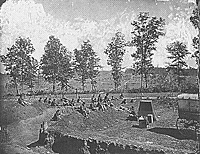
Bragg wanted to defend the fortifications of Tullahoma, but Polk was against the idea, pointing out that they, too, could be turned. Hardee sided with Bragg, but only to await further developments. By the next day, with Rosecrans again maneuvering against the army's rear, Bragg ordered a retreat across the Elk River, just south of Tullahoma, a movement that ultimately took the Confederate Army of Tennessee back to Chattanooga, effectively abandoning another state without a major fight.
In August, the tempo slowed again, as the Yankees paused to rebuild rail lines and bring up supplies for the next effort: crossing the Tennessee River to capture Chattanooga would require a major offensive. So too, were changes in store for the Confederates. Reinforcements were sent to join Bragg, including a division from the Department of East Tennessee, commanded by Major General Simon Bolivar Buckner. Buckner's command was technically independent, but given its size and geographic proximity to Bragg's force it made little sense to maintain it as such, especially after yet another Federal army largely overran East Tennessee.
In a typically Byzantine arrangement, however, Buckner's status remained vague -- he was subordinated to Bragg as a corps commander for operational matters, but was supposed to continue to manage the department's administrative affairs independently, a situation that inevitably would lead to confusion and jurisdictional fights over things like promotions and supplies. Next, Hardee was sent to Mississippi to command the scattered remnants of the Vicksburg defenders, replacing the former commander, John C. Pemberton. This left Hardee's corps command slot open, and it was filled not by internal promotion, but by the arrival of an outsider, newly promoted Lieutenant General Daniel Harvey Hill. Ultimately, both Buckner and Hill became strong anti-Bragg men and figured prominently in the postbattle squabbling.
Other reinforcements were gathered from more distant theaters. Half of the troops that Hardee had been sent to take charge of in Mississippi went instead to Bragg, adding another division or so to the rolls. Finally, the Government agreed to send one of Robert E. Lee's three corps from the Army of Northern Virginia: Lieutenant General James Longstreet brought two divisions from his command via a torturous rail route across most of the deep south. Longstreet's arrival was especially significant, as he was one of the most prominent officers in the Confederacy, and any opinions he had would carry great weight among his fellow soldiers. He would became a major player in the coming command crisis, and, again, not as a Bragg partisan.
Finally, Bragg's own health loomed as an issue. Bragg was almost never a well man, as his letters to Eliza attest. He suffered by most accounts from joint pain, indigestion, and migraine headaches. By mid-1863, he was sick often, including during Tullahoma and again at the start of the Chickamauga campaign.
Union on the Move
On August 16th, the Union army began to move, and again achieved considerable surprise. Rosecrans' first effort was a feint, aimed directly at Chattanooga. Union troops appeared on the north bank of the Tennessee opposite the town on August 21st, shelling the city and capturing Rebel pickets. Other Federals appeared upstream, in the direction of Knoxville. Bragg, recuperating at the mountain resort of Cherokee Springs' Georgia rushed back to Chattanooga that night, and prepared to meet a thrust from the northeast.
Rosecrans' main effort, however, was from the southwest. By August 28th, the bulk of the Union army had closed to the west bank of the Tennessee River downstream from Chattanooga, at Bridgeport, Alabama. Only one Rebel cavalry regiment screened the 60 miles of mountain passes south of the city, not nearly enough men to provide adequate warning of the Federal crossing.
By early September, Rosecrans' columns had crossed both the Tennessee River and Sand Mountain to take firm control of Lookout Valley, outflanking Bragg's position in Chattanooga. Again, the Rebel forces initiated a retreat. On September 8th, Bragg's men left the city open to Federal forces, who immediately took control.
This time, however, Bragg was working on a plan. Realizing that he was still outnumbered by the Federals, but expecting strong reinforcements daily, Bragg hoped to lure the Yankees into the mountains of north Georgia, where the various mountain ranges would prevent rapid co-ordination between the widely scattered Union columns. Then, drawing on the fresh troops rushing towards him, Bragg expected to defeat Rosecrans' forces piecemeal, trapped in the mountain valleys.
The initial phase of this scheme worked well: Rosecrans did his part, scattering his forces into three widely separated columns as they crossed Lookout Mountain. The 21st Corps under Major General Thomas Crittenden was the northern pincer, entering Chattanooga on the night of September 9th. In the center, Major General George H. Thomas and the 14th Corps crossed Lookout Mountain at Stevens Gap and entered MacLemore Cove, while Major General Alexander McCooles 20th Corps moved via the southernmost pass to reach the town of Alpine on September 9th. More than 20 miles, a days march or more in the rugged country separated each column. Rosecrans was willing to take such great risks because he thought he was chasing a beaten foe, and wanted to ensure that this time, Bragg would not escape as he had at Tullahoma.
Chickamauga The Army of Tennessee
- Introduction
Union on Offensive
Bragg Acts: McLemore's Cove
Battle of Chickamauga
Chickamauga as Simulation
Back to Table of Contents -- Against the Odds vol. 1 no. 2
Back to Against the Odds List of Issues
Back to MagWeb Magazine List
© Copyright 2003 by LPS.
This article appears in MagWeb.com (Magazine Web) on the Internet World Wide Web.
Other articles from military history and related magazines are available at http://www.magweb.com
* Buy this back issue or subscribe to Against the Odds direct from LPS.
